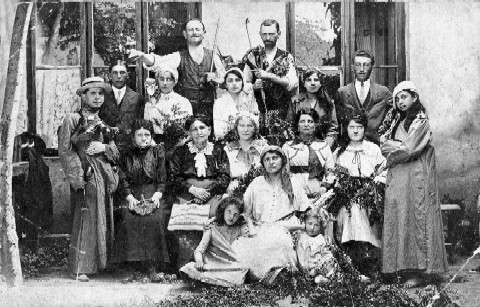
History of the Jewish Community in Kalisz: 12th Century to World War I
Community History
Located in the Poznan province west of Lodz, Kalisz was for centuries a border town between Poland and Germany. One of the oldest cities in Poland, Kalisz also played a pivotal role in Polish Jewish history: in 1264, Prince Boleslav V, Duke of Krakow, was the first to grant a charter to the local Jewish community, giving them settlement rights as well as certain religious and financial freedoms. This "Statute of Kalisz," expanded by later Polish rulers, provided the legal foundation for Jewish rights in Poland.
There had probably been Jews in Kalisz since the twelfth century, when refugees from the Crusader massacres fled to Poland from the Rhineland. Coins from the area stamped with names in Hebrew letters reveal that Jewish minters were active in the town during the twelfth century.
As Polish Jewry developed rapidly in the early modern period, so did the Kalisz Jewish community. In the mid-fourteenth century, Kalisz Jews received permission to build a synagogue, which stood for over four centuries until destroyed by fire.
The Kalisz Jewish community played an important role in the Council of the Four Lands, the supracommunal body that represented Polish Jewry to the king. Jews made their living as moneylenders, craftsmen, and import-export merchants dealing in livestock, horses, agricultural produce and textiles. The Jewish merchants of Kalisz played an important role at the international fairs in the German cities of Leipzig and Breslau.
The Jewish population declined somewhat in the seventeenth and eighteenth centuries, due to the disruption of the Polish-Swedish War (1655–1659), as well as fires and plague in the 1700s. Even so, by 1793—when the region was annexed by Prussia—Jews owned about a quarter of the buildings in the town. At that time Jews constituted 40 percent of the population of Kalisz; they dominated the textile trade and made up half the craftsmen in the town. From 1815 until 1914 Kalisz was under Russian rule.
Russian authorities expelled Jewish residents who lacked Russian citizenship from Kalisz in 1881. A few years later, by 1897, the Jewish population of the town numbered 7,580 or about one-third of the total population.
Economy
Over the course of the nineteenth century, Jews continued to play a leading role in the local economy. Indeed, Christian business leaders in Kalisz, hostile to Jewish competition, pressured the Russian authorities to create a special Jewish quarter where Jews would be required to live. The quarter was established in 1827, when Jews made up about a third of the population. After the arrival of the railroad in the 1870s, industry developed rapidly. Products included textiles, woolens, and—most importantly—lace.
Indeed, lacework and embroidery became the principal industry in Kalisz, which was known as the lacework capital of the Russian Empire. Many Jews made their living from it, whether as industrialists, middlemen, or factory workers. By the early twentieth century, Jews owned 32 of the 67 factories in the town. In 1904, Jews made up over half of Kalisz lace workers. Most of the Jews in Kalisz, however, were poor laborers or artisans.
Religious Life
Kalisz had already become an important spiritual center by the seventeenth century. In the nineteenth century, the pietist revival movement called "Hasidism" began to have an impact on the town. The first Hasidic sect to gain followers in Kalisz were the Kotskers, followed by the Ger and Alexander Hasidim. By the 1890s Kalisz boasted two large synagogues and close to 40 smaller prayer houses. Three more synagogues, including one in the style of German Reform Judaism, were built in Kalisz in the first decade of the twentieth century.
In the last half-century of Russian rule, as was the case throughout the Russian Empire, traditionalist Jews (both Hasidic and non-Hasidic) battled modernizers over issues such as education and the rabbinate.
Political Parties
Kalisz also had an array of Jewish political parties around the turn of the century: mainstream Zionist, labor Zionist, religious Zionist, and socialist Bundist. These differing political visions were mirrored in the Jewish schools of Kalisz which by World War I included a bilingual Jewish high school, two Yiddish-oriented schools, and an Orthodox educational network of 1,800 students.
World War I and its Aftermath
During the first year of World War I, the invading German army destroyed much of Kalisz and killed 33 Jews in the town.
In March 1919, Polish nationalists organized a pogrom—one of several postwar attacks throughout Poland—in which two Jews were murdered. An attempt to organize a second pogrom in 1920 was foiled by organized Jewish resistance.
Critical Thinking Questions
- Learn about the history of the Jewish community in your country.
- Learn about Kalisz today. How has its history and Jewish history informed the present community?

